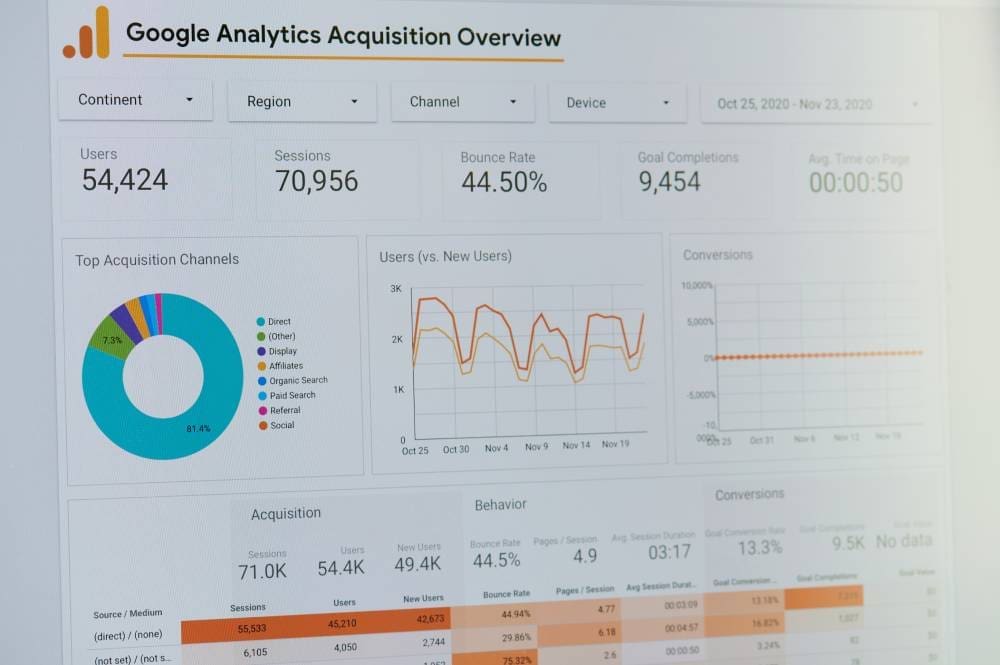You’ll more than likely be familiar with analytics in some capacity. They make up a core part of any campaign, showcasing where your results are, what they are, and where improvements can be made. Fundamentally, analytics are there to help drive your campaigns to be better, faster, smarter, and more focused. Google, like in so many other areas, has got the analytics arena completely sussed with their free web tool, Google Analytics. So what is GA4, and what specifically are the major differences to its predecessor.
Analytics started out as a very rudimentary way to view your site’s traffic data. Before Google’s first analytics version, viewing data was pretty problematic unless you were happy to get a computer science degree and trawl thousands of lines of log file data and code. Google wanted to bring analytics to more and more businesses, by taking this hidden data, and making it understandable to the everyday user. With each new version of analytics, of which there have been four major updates (including GA4), we have seen huge leaps in the way we view, share, engage, and assess our data.

So onto GA4 then. What are the major change points with GA4 when compared to the previous version, Universal Analytics (sometimes known as GA3). And more importantly, how exactly can they benefit your law firm?
What Is Different About GA4?
GA4 crucially uses a very different way of structuring the data it collects. The goal with GA4 is to help unify the way the customer journey works, and create a more thorough understanding of how a user interacts with your site. Previous versions of analytics used sessions to track users on your site. You can think of a session as a closed off container. Every action a user takes on your site within their one visit is collated into one folder, which is stored separate from the next session, or from any other users sessions. Leaving and returning would count as a 2nd session.
On the contrast, GA4 treats every single action on your website individually. Nothing is boxed into overall sessions, and instead every action is treated as its own event. If you view a page, download a pdf, click a link, fill out a contact box, etc. The major difference here is you can get far more insight into the events and parameters that matter to you, whilst from a marketing perspective, there is far more scope for cross-platform analysis, and predicting user behaviour. The 2nd major difference is the volume of metrics that you can track.

Of course there’s not only changes that come with a new version of analytics though. There’s new additions too. So what exactly are these new changes and additions, and how can they benefit your law firm?
Smarter Engagement Data
It’s hugely important to understand how users engage with your site. Whilst previously, engagement data might have been centred around bounce rates and session time, you now have many more metrics to take advantage of, like site search, scroll time, downloads, and video consumption. There’s a far greater understanding of how users interact with your content, and it can drive much smarter development of content in future.
New Cross Tracking
Google analytics can now track users across several different websites and apps of yours, which provides a far greater understanding of a users journey. Not only that, but device tracking is now far more accurate, with users being grouped into the same journey if they use several devices, when previously it would’ve counted as multiple. GA4 has the ability to track via 1st party cookies, which tracks within your site/sites across multiple devices. When cookies are not used, GA4 uses machine learning tracking to fill in the gaps. There is also the ability to track via Google signals, which is those with a Google account or ad personalisation enabled. Finally, GA4 enables tracking via User ID, which is when individuals are logged into your website across devices/browsers etc.
Smart Data Integration
Not only that, but GA4 has much smarter importation and integration of external data. 3rd-party data is a huge booming industry, and GA4 has a much smoother integration of their own Google data with other 3rd-party data to get a clearer picture of user journeys. Take for example 3rd-party data from areas like geography, demography, products, users, campaigns, or even commerce. They are all hugely beneficial to one another when integrated.
GA4 also integrates data from BigQuery with its smart machine learning algorithms, which is relevant if you have lots and lots of data. BigQuery is a data warehouse that can process SQL data at super speeds, and is a very powerful feature for free. As mentioned though, it’s generally more beneficial for businesses with lots and lots of data.
Predictive Metrics
This is a hugely progressive leap from previous analytics versions. Predictive data is simply what it says on the tin. Google uses AI to better predict purchase probability, churn probability, and revenue probability.
- Purchase probability is the likelihood of a user from within the last 28-days making a purchase within the next 7 days.
- Churn probability is the likelihood of a user from the last 28-days not returning to your site within the next 7 days.
- Revenue probability is the rough projected revenue for the next 28-days based on the current users of the last 28-days.

The benefit of this predictive data allows you to make calculated decisions at the right time, or to create targeted campaigns to the right audience.
Enhanced Segment Building
GA4 allows you to create much more customised segments. There is more focus on actions that users take individually, instead of collectively. You can track a specific event which you couldn’t previously, like if a user downloads a certain PDF. You can also add the concept of time into your segments, and track how long users take between 2 different events in your sales funnel.
Final Thoughts
If you’d like any more assistance with GA4, or would like to chat about how it can be integrated as part of your digital marketing strategy, please contact us here for a free consultation.





